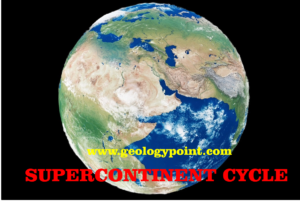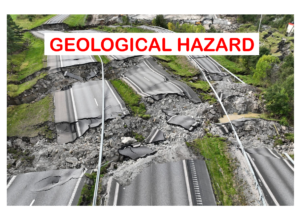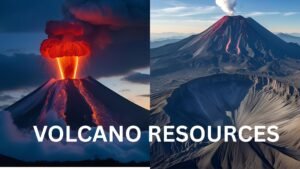The Earth beneath us may seem solid and immovable, but geologists know it hides a complex and dynamic interior. From fiery molten layers to solid metal cores, the Earth’s internal structure is a fascinating story of formation, transformation, and motion. Understanding what lies beneath the surface isn’t just an academic exercise; it helps us explain earthquakes, volcanic eruptions, mountain building, and even the Earth’s magnetic field.
Let’s journey together from the crust we walk on to the deep core we can only imagine, exploring each layer of the Earth’s interior in a way that connects science with human curiosity and wonder.
Layers of Earth
Unlike outer space, we can’t directly see inside the Earth. The deepest hole ever drilled—the Kola Superdeep Borehole in Russia—reached just about 12 kilometers, a tiny scratch on the surface compared to Earth’s 6,371 km radius. So, how do scientists know what’s beneath?
They rely on indirect evidence, especially seismic waves from earthquakes. These waves travel differently through solids, liquids, and varying densities. By analyzing how they bend, reflect, and slow down, geologists have mapped the internal structure of the Earth into three major layers: the crust, the mantle, and the core. Each is unique in composition, behavior, and role in Earth’s geology.

The Crust
The Earth’s crust is the outermost solid layer of our planet, forming the surface we live on. It is a thin, brittle shell compared to the layers beneath it, yet it plays a crucial role in the Earth’s structure, geologic activity, and the development of life. The crust is where mountains rise, continents drift, oceans rest, and all human activity takes place. Despite being just a thin layer in Earth’s overall structure, it holds the key to understanding plate tectonics, rock formation, and Earth’s geologic history.
Types of Crust:
There are two main types of Earth’s crust:
- Continental Crust:
This crust makes up the continents and is thicker (30–70 km) but less dense. It is primarily composed of granitic rocks rich in silicon (Si) and aluminum (Al), often referred to as “sial.” The continental crust is older and more complex, with some parts dating back over 4 billion years. It is constantly being reshaped by tectonic forces, erosion, and volcanic activity. - Oceanic Crust:
Found beneath the oceans, this crust is thinner (5–10 km) but denser than continental crust. It is made mainly of basalt, which is rich in iron (Fe) and magnesium (Mg)—hence referred to as “sima.” Oceanic crust is relatively young, with most areas being less than 200 million years old, as it is continuously formed at mid-ocean ridges and destroyed at subduction zones.
Composition and Structure:
The crust is made up of igneous, metamorphic, and sedimentary rocks. The most abundant elements in the crust are oxygen, silicon, aluminum, iron, calcium, sodium, potassium, and magnesium. These elements combine to form common minerals like quartz, feldspar, mica, and amphibole. Structurally, the crust is broken into tectonic plates that float on the semi-fluid upper mantle or asthenosphere. These plates move slowly but steadily, causing earthquakes, volcanic activity, and mountain building.
Mohorovičić Discontinuity (Moho):
The boundary between the Earth’s crust and the underlying mantle is called the Mohorovičić Discontinuity, or Moho. It was discovered by seismologist Andrija Mohorovičić in 1909, based on the change in speed of seismic waves. The Moho marks a distinct change in rock composition—from crustal rocks to denser mantle peridotite.
Importance of the Crust:
Understanding the crust helps in earthquake prediction, mineral exploration, and environmental protection.lcanoes, and continental drift. Despite being thin, the crust is geologically active and constantly reshaped over millions of years. It is the source of natural resources like minerals, metals, fossil fuels, and building materials. It supports ecosystems, soils, forests, and water systems necessary for life. The crust acts as the foundation for tectonic processes, including mountain formation and continental drift.
The Mantle
The mantle is one of the primary layers of the Earth, located between the outer crust and the deeper core. It extends from a depth of around 35 kilometers to about 2,900 kilometers, making it the thickest layer, accounting for nearly 84% of Earth’s volume. Though mostly solid, the mantle behaves plastically over long periods, allowing slow flow that drives tectonic plate movements and causes volcanic and seismic activity.
Structure of the Mantle:
Geologists divide the mantle into two major sections: the upper mantle and the lower mantle. The upper mantle starts just beneath the crust and includes the asthenosphere, a partially molten, ductile zone that allows tectonic plates to move. Above the asthenosphere is the lithosphere, a rigid outer layer that includes both the crust and the uppermost mantle. The lower mantle, extending from 660 km to about 2,900 km, is under much higher pressure and temperature, causing it to be denser and behave more rigidly than the upper mantle, although it still flows over long timescales.
Composition and Temperature:
The mantle is composed mainly of silicate minerals rich in magnesium and iron, such as olivine, pyroxenes, and garnet. With increasing depth, these minerals transform into high-pressure forms like perovskite. Temperatures in the mantle range from about 500°C near the top to over 4,000°C near the boundary with the core. Despite this intense heat, the mantle remains solid due to the enormous pressure, but it behaves like a slow-moving solid capable of flowing—a property essential for mantle convection.
Mantle Convection and Its Role:
One of the most important features of the mantle is convection—the slow, churning movement of mantle material caused by the escape of heat from Earth’s interior. These convection currents are what drive plate tectonics, causing continents to drift, ocean floors to spread, and mountains to form. This process is also responsible for earthquakes, volcanic eruptions, and the formation of new crust at mid-ocean ridges. The mantle, therefore, is not a static layer but an active engine shaping Earth’s surface and geology.
Mantle Plumes and Hotspots:
In some places, hot, buoyant material rises directly from deep within the mantle in what are called mantle plumes. These plumes can create hotspots, resulting in isolated volcanic islands like Hawaii or geothermal features like Yellowstone. These volcanic activities often occur far from tectonic plate boundaries, highlighting the dynamic nature of the mantle beneath stable regions of the crust.
How We Study the Mantle?
Direct access to the mantle is impossible due to its depth, but scientists learn about it through seismic waves, volcanic rocks brought up from deep within the Earth, laboratory experiments, and geophysical modeling. Seismic waves, especially, provide a map of the mantle’s properties, helping researchers understand its composition, temperature, and behavior.
The Core
At the very center of our planet lies the core, Earth’s innermost layer. It begins at a depth of around 2,900 kilometers beneath the surface and extends all the way to the center of the Earth, about 6,371 kilometers deep. The core plays a critical role in Earth’s magnetic field, heat production, and overall internal dynamics. Despite being completely inaccessible, scientists have learned much about the core through the study of seismic waves and high-pressure laboratory experiments.
Structure of the Core:
The core is divided into two distinct parts: the outer core and the inner core.
The outer core is a liquid layer, approximately 2,200 kilometers thick, composed mainly of molten iron and nickel. This flowing liquid metal is responsible for generating Earth’s geomagnetic field through a process called the geodynamo. Beneath the outer core lies the inner core, a solid sphere with a radius of about 1,220 kilometers. Despite the extreme temperatures, which may reach up to 5,700°C, the inner core remains solid due to the tremendous pressure at Earth’s center. It is composed primarily of iron, along with small amounts of nickel and other elements.
Composition and Properties:
The core is composed mainly of metallic iron, with lesser amounts of nickel, sulfur, oxygen, and possibly silicon. The difference in composition and state (liquid outer vs. solid inner) is caused by variations in pressure and temperature with depth. The density of the core is much higher than that of the mantle or crust, which reflects its metallic nature. The outer core behaves like a turbulent, convecting fluid, whereas the inner core is more rigid but may slowly rotate and have complex structural variations.
The Core and Earth’s Magnetic Field:
One of the most important functions of the outer core is its role in generating Earth’s magnetic field. The movement of molten iron in the outer core creates electric currents, which in turn generate a magnetic field around the Earth. This magnetic field is essential for life—it shields the planet from harmful solar radiation and cosmic rays, and helps guide compasses for navigation.
How Do We Know About the Core?
Although no one has ever drilled to the core, scientists study it using seismic waves from earthquakes. When these waves travel through Earth, they behave differently in solids and liquids. For example, S-waves (shear waves) cannot pass through liquids, which helped scientists confirm the existence of the liquid outer core. Meanwhile, P-waves (primary waves) can travel through both solid and liquid but change speed and direction, offering clues about density and composition. Computer models and lab simulations under extreme conditions also help us understand how the materials in the core behave.stimate its composition and behavior.
The lithosphere
The lithosphere is the outermost rigid layer of the Earth. It includes both the crust (continental and oceanic) and the uppermost part of the mantle. This layer is relatively cool and solid, extending to a depth of about 100–200 kilometers, although the thickness can vary depending on tectonic setting.
- The lithosphere is broken into tectonic plates, which float on the softer, more ductile asthenosphere beneath.
- It is strong and brittle, which makes it prone to fracturing, resulting in earthquakes and the formation of faults.
The Asthenosphere
Beneath the lithosphere lies the asthenosphere, a zone in the upper mantle that extends from about 100 km to 350 km deep. This layer is hot, weak, and ductile, meaning it can flow slowly over time like very thick, warm taffy.
- The asthenosphere is partially molten, allowing the tectonic plates of the lithosphere to move over it.
- It acts as a conveyor belt for plate movement and is crucial in mantle convection, which drives tectonic processes.
Key Differences Between Lithosphere and Asthenosphere
| Feature | Lithosphere | Asthenosphere |
|---|---|---|
| Composition | Crust + uppermost mantle | Upper mantle (partially molten) |
| Physical State | Rigid and brittle | Ductile and semi-fluid |
| Depth Range | ~0–100/200 km | ~100–350 km |
| Role in Plate Tectonics | Forms tectonic plates | Allows plates to move above it |

Why understanding Earth’s interior matters?
We might never visit the mantle or core, but knowing about them helps solve real-world problems.
- Earthquakes: Seismic waves help locate fault zones and understand where stress is building up.
- Volcanic Eruptions: Magma originates in the upper mantle. Understanding mantle plumes can aid in predicting eruptions.
- Natural Resources: Many valuable minerals and energy sources are formed by geological processes tied to Earth’s internal heat.
- Magnetic Field: The outer core’s motion shields us from harmful solar radiation, preserving our atmosphere and enabling life.
- Plate Tectonics: The movement of lithospheric plates explains the distribution of continents, mountain ranges, and ocean basins.
In essence, studying Earth’s interior is like learning the anatomy of a living organism. It helps us diagnose problems, make predictions, and appreciate the complexity of the world we inhabit.
Deep Earth exploration
What’s truly remarkable is the human effort behind our understanding of the Earth’s interior. From the early speculations of Greek philosophers to modern geophysics, this knowledge has been built layer by layer, just like the Earth itself.
Think of seismologists analyzing wave patterns from earthquakes, engineers building high-pressure lab equipment to simulate core conditions, or geologists piecing together rock clues from deep mines and volcanic eruptions. It’s a global, interdisciplinary effort driven by curiosity.
Even astronauts studying other planets use what we know of Earth’s structure as a model to understand Mars or the Moon. Our own planet becomes a cosmic reference point.
FAQs on the internal structure of Earth
1. What are the main layers of the Earth?
The Earth is divided into four main layers: the crust, mantle, outer core, and inner core. These layers are classified based on their chemical composition and physical properties. The crust is the outermost solid layer, followed by the thick, semi-solid mantle. Below the mantle lies the liquid outer core, and at the center is the solid inner core.
2. What is the difference between the crust and the lithosphere?
The crust is the thin, outermost layer of the Earth, made up of solid rock. The lithosphere includes the crust and the uppermost part of the mantle. It is a rigid, brittle layer that forms the Earth’s tectonic plates. So, while all crust is part of the lithosphere, the lithosphere also includes a portion of the mantle.
3. Why is the mantle important?
The mantle makes up about 84% of Earth’s volume and is crucial for heat transfer from the interior of the Earth to the surface. It is mostly solid but behaves like a very slow-moving fluid in its deeper parts, allowing for mantle convection. This movement drives plate tectonics, leading to earthquakes, volcanic activity, and mountain building.
4. What is the role of the Earth’s core?
The core, especially the liquid outer core, plays a vital role in generating Earth’s magnetic field through the geodynamo effect—the motion of molten iron creates electric currents. The inner core is solid due to immense pressure and helps maintain the structural stability of the planet’s interior.
5. How do scientists know what lies inside the Earth?
Since we can’t directly access most of Earth’s interior, scientists study seismic waves generated by earthquakes. These waves change speed and direction as they move through different layers. By analyzing their behavior, scientists infer the composition, density, and state (solid or liquid) of internal layers. Laboratory experiments and computer models also contribute to our understanding.
6. What is the asthenosphere, and how is it different from the lithosphere?
The asthenosphere is a soft, ductile layer of the upper mantle located beneath the lithosphere. It extends from about 100 to 350 km deep. Unlike the rigid lithosphere, the asthenosphere can flow slowly, which allows tectonic plates (the lithosphere) to move over it.
7. Why is the Earth’s magnetic field important?
The Earth’s magnetic field, generated by the liquid outer core, protects the planet from harmful solar wind and cosmic radiation. It also makes navigation possible using compasses. Without this field, Earth’s atmosphere could be stripped away by solar particles.
8. What is the Mohorovičić discontinuity (Moho)?
The Moho is the boundary between the crust and the mantle. It was discovered by Andrija Mohorovičić and is identified by a sudden increase in the velocity of seismic waves. This discontinuity marks a change in composition from lighter crustal rocks to denser mantle rocks.
9. Are all parts of the Earth solid?
No. While the crust, mantle, and inner core are solid or semi-solid, the outer core is completely liquid, composed mainly of molten iron and nickel. The behavior of seismic waves confirms the liquid nature of this layer.
10. How thick are the Earth’s layers?
Approximate thicknesses are:
- Crust: 5–70 km
- Mantle: ~2,900 km
- Outer core: ~2,200 km
- Inner core: ~1,220 km






I’ve been browsing online more than 3 hours today, yet I never discovered any interesting article like yours. It is lovely worth enough for me. In my opinion, if all web owners and bloggers made just right content as you did, the internet will be a lot more useful than ever before.